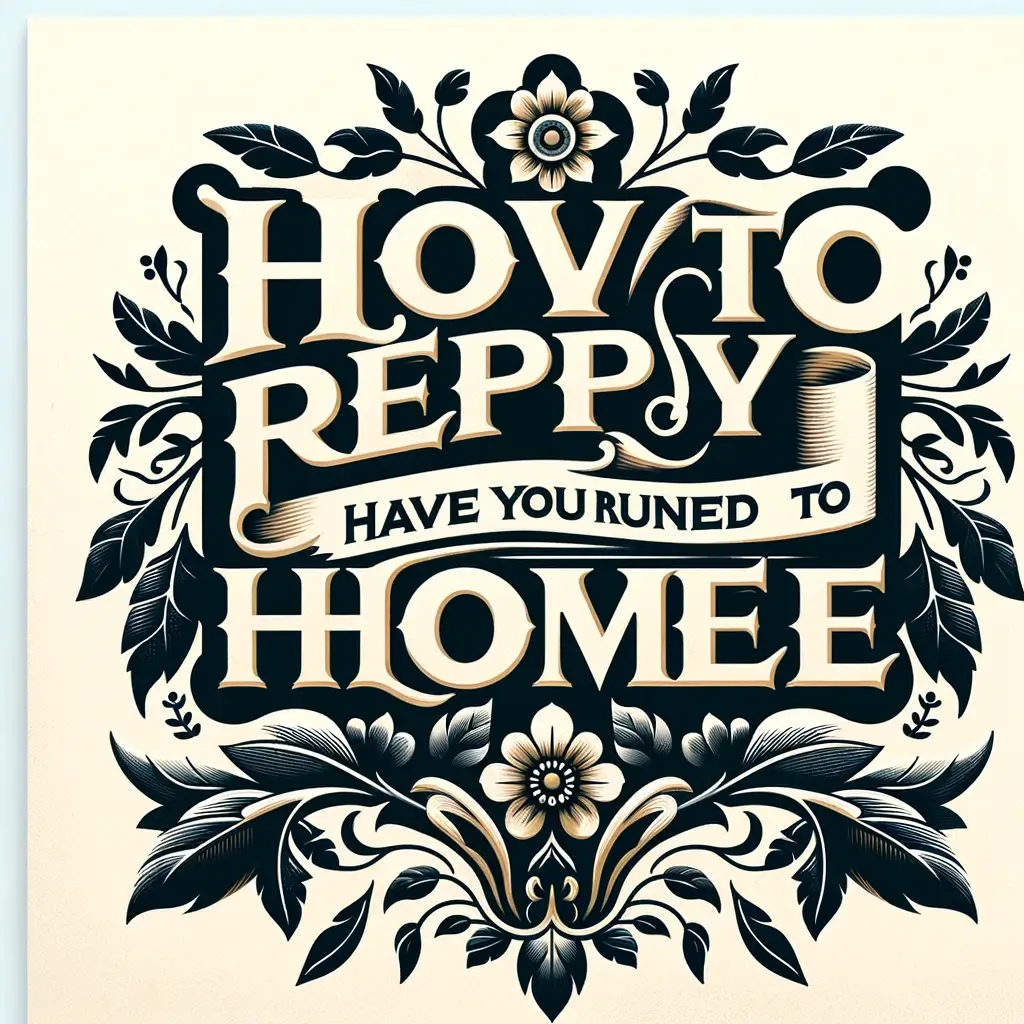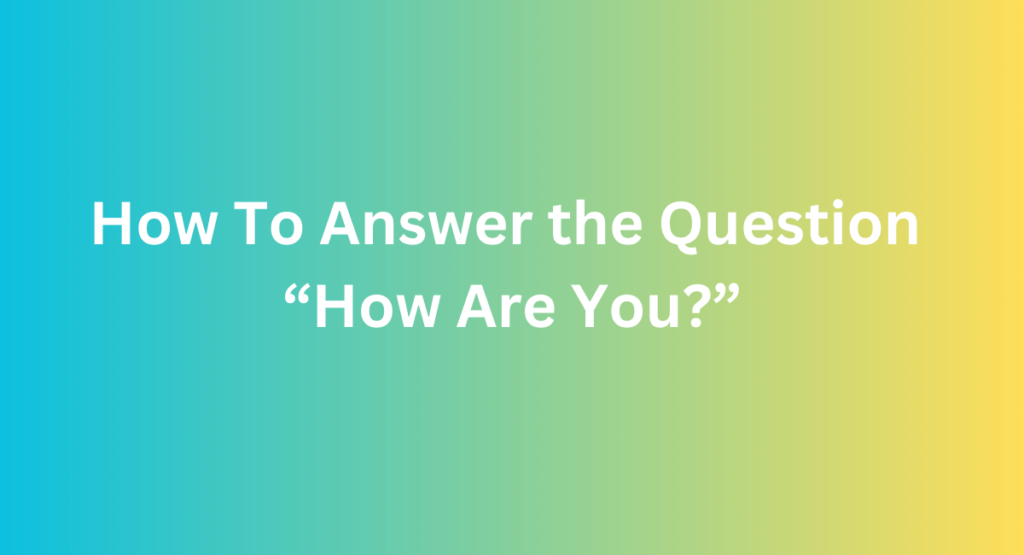
**Short Answer:** Yes, I have reached home safely. Thank you for asking.
**** Reaching home safely is often a concern for loved ones. It signifies the end of a journey and the beginning of relaxation. Communicating your safe arrival reassures those who care about you. This simple exchange helps strengthen bonds and provides peace of mind.
Whether you’ve had a long day at work or a brief outing, letting others know you’re home safely is a considerate gesture. Effective communication, even in brief messages, plays a vital role in maintaining connections. Sharing your status promptly and clearly reflects your thoughtfulness and reliability. It’s an easy way to show you care and value the concern of others.
Understanding The Importance Of Responding
When someone asks, “Have you reached home?” they show care and concern. Understanding the importance of responding to this question helps maintain healthy relationships. It demonstrates respect and ensures peace of mind for the person asking.
Reasons To Respond
Responding to the question, “Have you reached home?” is crucial. Here are some reasons why:
- Shows Appreciation: It acknowledges the person’s concern for your safety.
- Builds Trust: Regular responses build and maintain trust in relationships.
- Ensures Safety: Responding confirms your safety, especially during late hours or bad weather.
- Reduces Worry: A quick reply reduces unnecessary worry for the person who cares.
Consider this simple scenario:
| Scenario | Response | Outcome |
|---|---|---|
| Late night arrival | Yes, I’m home | Peace of mind for loved ones |
| Bad weather conditions | Reached safely | Relief and less anxiety |
In all these cases, a quick response goes a long way in showing you care about their feelings.
Impact Of Not Responding
Not responding to “Have you reached home?” can have negative effects. Here’s what can happen:
- Increased Worry: People may worry more if they don’t hear back from you.
- Trust Issues: Lack of response can lead to trust issues over time.
- Misunderstandings: The person might think you are ignoring them.
- Strained Relationships: Repeatedly not responding can strain your relationships.
Consider these potential impacts:
| Scenario | No Response | Impact |
|---|---|---|
| Late night arrival | No reply | Increased worry and anxiety |
| Bad weather conditions | Silence | Fear and panic |
By understanding these impacts, we see that a simple response can prevent many negative emotions and situations. Communication keeps relationships strong and healthy.
Crafting A Polite And Prompt Reply
Have you ever received a text asking, “Have you reached home?” Responding to such messages politely and promptly is crucial. This shows respect and care for the person who is concerned about your safety. Let’s explore some tips on crafting a polite and prompt reply.
Acknowledge The Message
First, it’s important to acknowledge the message. This shows you have seen their concern and are responsive. A simple acknowledgment can go a long way in maintaining good communication. Here are a few examples:
- “Yes, I just reached home.”
- “I’m home now, thank you for checking.”
- “Made it home safely, thanks for asking.”
If you haven’t reached home yet, let them know where you are or how long it will take:
- “Not yet, still on my way. I’ll be home in 10 minutes.”
- “I’m stuck in traffic, but should be home soon.”
Acknowledge their message promptly to avoid unnecessary worry. This simple act of recognition helps in maintaining a positive relationship.
Express Concern
When replying, it’s also good to express concern for their well-being. This shows that you care about them too. Some ways to express concern include:
- “How was your journey back?”
- “Hope you reached home safely as well.”
Here is a table that summarizes some polite phrases:
| Scenario | Response |
|---|---|
| If they are still traveling | “Be safe on your way home.” |
| If they might be worried | “Don’t worry, I’m safe. How about you?” |
By expressing concern, you ensure a balanced and caring conversation. This helps build a stronger relationship.
Provide Reassurance
Finally, it’s essential to provide reassurance. This helps to ease any worries the other person may have. Here are some reassuring responses:
- “I’m home safe and sound, no need to worry.”
- “Everything is fine, made it back without any issues.”
If there were any issues, address them calmly:
- “Had a minor delay, but I’m safe now.”
- “Got stuck for a bit, but I’ve reached safely.”
Providing this kind of reassurance helps the other person feel relieved. It also shows that you value their concern and are mindful of their feelings.
In summary, a well-crafted response includes acknowledging the message, expressing concern, and providing reassurance. This approach ensures clear and empathetic communication.
Sample Responses
When someone asks, “Have you reached home?”, it’s polite to respond promptly. Crafting the right response can show your personality and create stronger connections. Here are some sample responses to consider:
Short And Simple Reply
Sometimes, a straightforward answer is the best. You can keep your reply brief and to the point. This way, the person knows you are safe and sound.
- Yes, I am home.
- Just got in!
- Home now.
If you prefer to add a bit more detail but still keep it concise, you can try:
- Yes, I reached home safely.
- Made it home. Thanks for asking!
- I’m home. Hope you are too.
Consider using emojis to add a friendly touch:
- Yes, I am home 😊.
- Just got in! 🏡
- Home now 🙌.
Adding A Personal Touch
Personalizing your response can make the person feel valued. Share a little about your journey or how you feel after reaching home.
- Yes, I just got home. The traffic was crazy!
- Finally home! It feels so good to be back.
- Made it home. Time to relax now.
You can also ask about their day to show interest:
- Yes, I reached home. How was your day?
- Home now. Did you get home safely too?
- Yes, I am home. What about you?
Sharing a bit of your plan adds warmth:
- Yes, I just reached home. About to make some dinner.
- Home now. Going to watch a movie.
- Yes, I am home. Settling in with a good book.
Using Humor
Humor can make your response more engaging and memorable. A funny reply can lighten the mood and bring a smile.
- Yes, finally home. My couch missed me!
- Made it home. The cat has already taken my spot.
- Home sweet home. Time to become a burrito with my blanket.
Try some playful responses:
- Yes, I am home. My bed is calling my name.
- Home now. The fridge is my next stop.
- Yes, I reached home. Ready for a nap!
Adding a bit of exaggeration can be fun:
- Yes, I am home. Survived the wild traffic!
- Made it home. Barely escaped the grocery store madness.
- Yes, finally home. It was an epic journey!
Considerations For Different Situations
Replying to the question “Have you reached home?” can sometimes be tricky. Different situations call for different responses. Understanding how to handle these scenarios ensures you stay polite and safe. Here are some considerations for different situations.
When You’re Busy
Sometimes, you might be in the middle of something important. Here’s how to reply efficiently:
- Quick Responses: Send a brief message like “Almost there!” or “Just a few more minutes.”
- Pre-written Texts: Have pre-written texts ready. For instance, “Can’t talk now, but I’ll be home soon.”
Consider using a table of common responses:
| Situation | Response |
|---|---|
| Meeting | “In a meeting, talk later.” |
| Cooking | “Cooking dinner, almost home.” |
| Working Out | “At the gym, will update soon.” |
These short replies keep the conversation polite and let the other person know you’re busy. It’s crucial to be honest and brief. This avoids misunderstandings and keeps everyone informed without taking too much of your time.
When You’re Driving
Safety is paramount when driving. Responding to texts can be hazardous. Here are some tips to stay safe:
- Use Hands-Free Devices: Set up your phone to send an automatic response. For instance, “Driving now, will text when I get home.”
- Pull Over Safely: If you must reply, pull over to a safe location first.
Here’s a sample of automatic replies:
| Device | Auto-Reply |
|---|---|
| iPhone | “Driving. Will reply when I can.” |
| Android | “Currently driving. Will update soon.” |
Using these methods ensures you stay safe while driving. It also keeps the other person informed about your status. Avoiding distractions on the road is crucial. Safety should always come first.
When You’re Out Of Network
Being out of network can complicate communication. Here’s how to handle it:
- Inform in Advance: Let people know you might be out of network. For example, “Heading to a place with poor signal.”
- Use Wi-Fi: When you find a Wi-Fi hotspot, send an update. For instance, “Just found Wi-Fi, heading home.”
Consider a table of useful phrases:
| Situation | Response |
|---|---|
| Traveling | “Might lose signal, update you soon.” |
| Hiking | “In a no-signal area, will text when I can.” |
These responses ensure the other person isn’t worried. It’s essential to communicate clearly before entering areas with poor connectivity. This way, everyone knows what to expect. Staying connected, even in challenging areas, helps keep everyone informed and at ease.
Alternative Ways To Confirm Safety
When someone asks, “Have you reached home?” they care about your safety. There are many ways to let them know you are safe. Here are some alternative ways to confirm your safety.
Using Location Sharing Apps
Location sharing apps are a great way to confirm safety. These apps show your real-time location. This makes it easy for others to know where you are. Here are some popular apps you can use:
- Google Maps: Share your live location for a set time.
- WhatsApp: Use the live location feature to share your whereabouts.
- Find My Friends: A dedicated app for sharing locations with friends and family.
These apps are easy to use. Just follow these steps:
- Open the app on your phone.
- Select the ‘Share Location’ option.
- Choose the contacts you want to share with.
- Set the duration for sharing your location.
Using these apps has many benefits:
| Benefit | Details |
|---|---|
| Real-time Updates | Others can see your location in real-time. |
| Peace of Mind | Your loved ones will know you are safe. |
| Easy to Use | These apps are user-friendly and quick to set up. |
Calling Instead Of Texting
Sometimes, a call is better than a text. Calling gives immediate confirmation of your safety. Here are some reasons why calling is better:
- Instant Confirmation: You get an immediate response.
- Personal Touch: A call feels more personal and caring.
- Clarity: It’s easier to understand tone and context.
Here are some tips for making a call:
- Ensure your phone is charged.
- Find a quiet place to talk.
- Keep the conversation short but clear.
- Let them know you are safe and at home.
Calling has several advantages:
| Advantage | Details |
|---|---|
| Immediate Feedback | You know right away if they understood you. |
| Emotional Connection | Voice calls create a stronger bond. |
| Less Miscommunication | Tone and context are clearer in calls. |
Etiquette For Requesting Confirmation
When someone asks, “Have you reached home?” it’s important to respond politely and promptly. This simple question shows care and concern. Knowing the proper etiquette for requesting and confirming arrival ensures good communication. Here’s how to master the etiquette for requesting confirmation:
Being Clear And Concise
When asking if someone has reached home, clarity and brevity are key. A clear, concise message saves time and prevents misunderstandings. Here are some tips:
- Use direct language: Ask straight away if they have reached home.
- Keep it short: A short message is easy to read and reply to.
- Avoid extra details: Focus on the main question without adding unnecessary information.
Here is an example of a clear and concise message:
Hey, just checking if you've reached home safely?Avoid long-winded messages like:
Hey, I was just wondering if you have reached home yet. I hope your journey was smooth and you didn't face any trouble on the way.To make your message more effective:
- Use simple words: Choose easy words that everyone understands.
- Be polite: A polite tone shows respect and concern.
Avoiding Repeated Messages
Sending multiple messages can be annoying and stressful. It’s important to be patient and not bombard the receiver with repeated queries. Here are some guidelines:
- Send one message: Wait for a reply before sending another message.
- Give them time: They might be busy or unable to reply immediately.
- Avoid multiple platforms: Don’t send the same message on different apps.
If you must send a follow-up message, wait a reasonable amount of time. Here’s how you can do it politely:
Hey, just checking in again. Did you reach home?Sending messages repeatedly like this can be frustrating:
Hey, are you home yet? Please reply. Hey, did you reach home? Why aren't you replying?To ensure good etiquette:
- Be patient: Trust that they will respond when they can.
- Respect their time: Understand they might be occupied.
Good communication respects both sender’s and receiver’s time and attention.
Understanding The Concern Behind The Question
Getting asked, “Have you reached home?” is a common query. Many people wonder how to reply to this. But first, understanding the concern behind the question is essential. This question often stems from genuine care, worry, and a desire to ensure your safety. Let’s delve into the deeper meaning behind this thoughtful query.
Safety And Security
When someone asks if you have reached home, they are primarily concerned about your safety and security. Here are a few reasons why:
- They want to know you are out of any immediate danger.
- They care about your well-being and want to ensure you are safe.
- They understand that travel can sometimes be risky.
Responding to this query assures them that you are okay. A simple, “Yes, I have reached home safely” can put their mind at ease. If you want to be more detailed, you can include additional information:
| Response | Details |
|---|---|
| Yes, I am home. | Short and to the point. |
| Yes, I reached home safely. | Assures them of your safety. |
| Yes, I am home. The journey was smooth. | Provides additional reassurance. |
Caring And Worry
Another reason people ask if you have reached home is out of caring and worry. They are genuinely concerned about you. This concern can stem from various factors:
- They love you and want to know you are safe.
- They might have had bad experiences while traveling.
- They want to ensure you are comfortable and settled.
When replying to such a question, it’s essential to acknowledge their concern. A simple, heartfelt message can make a difference. Here are a few examples:
- “Yes, I am home. Thank you for checking.”
- “Yes, I reached home. Your concern means a lot.”
- “Yes, I am home. The trip was good, and I appreciate your care.”
These responses show gratitude and acknowledge their worry. By doing so, you strengthen your bond and show appreciation for their concern.
Frequently Asked Questions
How To Reply For “have You Reached Home”?
Yes, I’ve just reached home. Everything is fine. How about you?
What Do You Say When Someone Reaches Home?
Welcome home! How was your trip? Glad you made it back safely. Let’s catch up soon!
How Do I Respond To “i Have Arrived Safely”?
Great to hear! Glad you’re safe. How was your journey?
How To Ask If Someone Has Reached Safely?
You can ask, “Did you reach safely? ” Or “Have you arrived safely? ” These questions are clear and show concern.
Conclusion
Mastering the art of replying to “Have you reached home? ” Is simple yet essential. Clear, concise responses show consideration and reliability. Remember, prompt communication fosters stronger relationships. Use these tips to ensure your replies are always thoughtful and effective.
Stay connected, stay safe, and happy texting!


